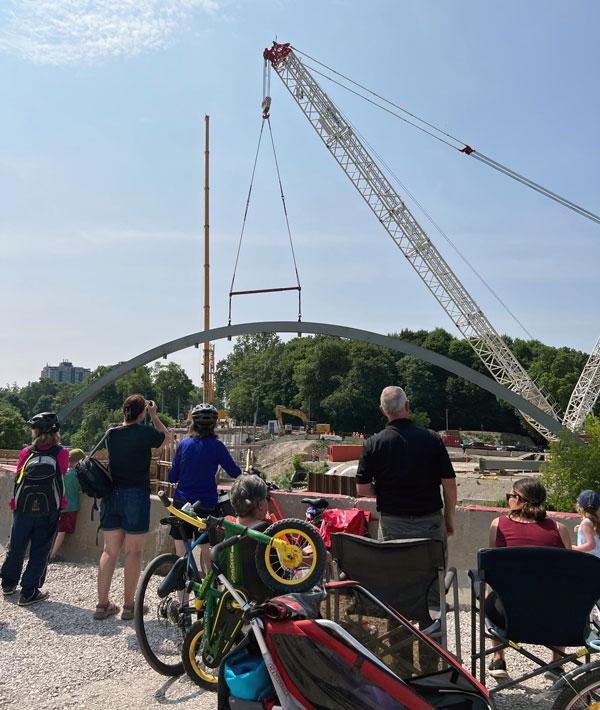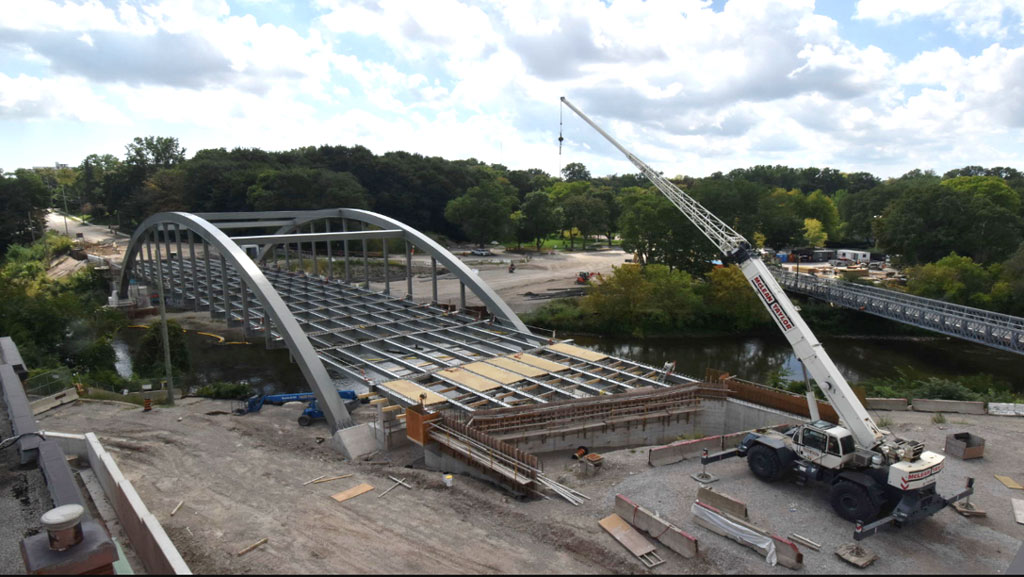Community eyes are watching as a bridge replacement near downtown London, Ont., nears completion.
And the enthusiastic response to the project is giving those involved a sense of how much this connection between one of the city’s oldest neighbourhoods and its downtown means to the people it serves.
“We had families and all sorts of folks out with their lawn chairs,” says Jennie Dann, London’s director of construction and infrastructure, of the June 20 installation of the first of two 130-tonne steel arches to support the new Victoria Bridge.
The bridge crosses the Thames River and connects the city’s Old South neighbourhood to the downtown core.
The age of the previous “Warren pony truss” bridge had triggered the nearly $23 million project, says Garfield Dales, the city’s division manager of transportation and design.
Built in 1926, the bridge was well over 90 years old by the time construction began in 2022, and some of its footing elements were 140 years old.
“It had certainly reached the end of its useful life.”
The project not only replaces an older structure but also ensures the crossing can better withstand the effects of climate change. The new through-arch steel structure removes the need for a central pier mid-river that often snagged debris at times of high flows, creating the risk of ice dams and flooding.
St. Marys-based McLean Taylor Construction Limited is the general contractor for the project.

Dann says the project has mostly been straightforward. The trickiest challenge, she says, came early on when work to dismantle the existing footings paused so that the city, the federal Department of Fisheries and Oceans and the Ontario Ministry of the Environment and Climate Change could hone plans to protect the habitat of the silver shiner minnow, a species at risk in Ontario, and mussels in the waterbed.
To relocate the mussels, the environmental specialists used a method called “raccooning,” which involved breaking the affected riverbed into one-metre square sections, “and they will literally root with their hands to try to find any mussels within the area,” she says.
The specialists relocated the mussels upstream.
Crews also built a truss bridge to the centre pier to avoid habitat disruptions while transporting equipment to dismantle the old structure.
The truss bridge was not the only temporary bridge installed for the project: a modular bridge was also established nearby to carry the sewer and watermain carried by the old bridge and to provide a crossing for pedestrians and cyclists.
“That went in as one of the early phases of the project,” says Dales.
City documents indicate the bridge, rented from Algonquin Bridge, a division of AIL International Inc., cost an additional $400,000.
Another aspect of the project that required careful planning, he says, was raising the profile of the adjoining roadway by more than a metre.
“That also provides some enhanced protection against rising river levels,” he explains.
Planning for the roadway work closely involved London Hydro, whose head office is adjacent to the area under construction. The utility’s vehicle entrance has had to be adjusted.
City officials initially anticipated the reconstruction project would be complete in 2023, but the opening is now pushed “to as early as possible in 2024,” Dales says.
He says obtaining the environmental approvals early in the project is the main reason for the revised timeline.
Once opened, the bridge will feature a widened deck to make room for a new biking lane for cyclists, a sidewalk on the bridge’s east side and a multi-use path on the west side that will link to a path along the river.
Improvements to the path on the north riverbank beneath the bridge, as well as to the adjacent Thames Park to the southwest (whose tennis courts have been used as a staging area for the project), are also in the plans, and these features will be completed in the project’s final stages.
Dales says the project is on budget, noting other components, such as the temporary pedestrian bridge, were handled outside of the main contract.
Once in use, Dales anticipates the bridge could serve the public for as long as its predecessor.
“We typically look for a design life somewhere between 75 and 100 years,” he says.



Recent Comments
comments for this post are closed